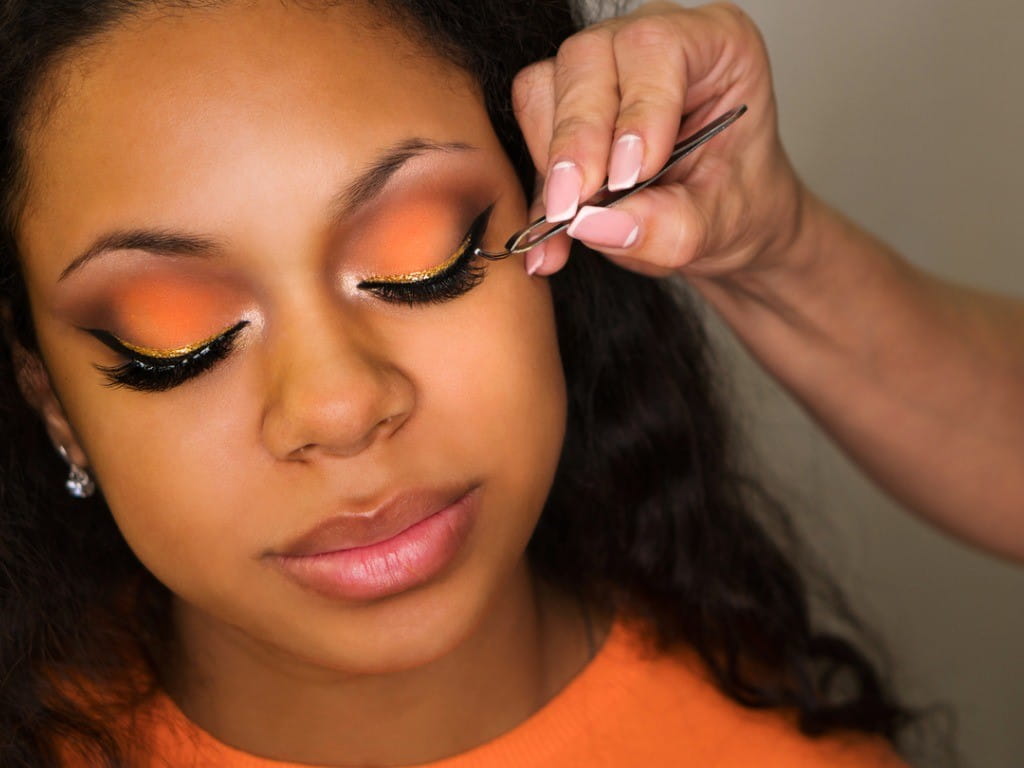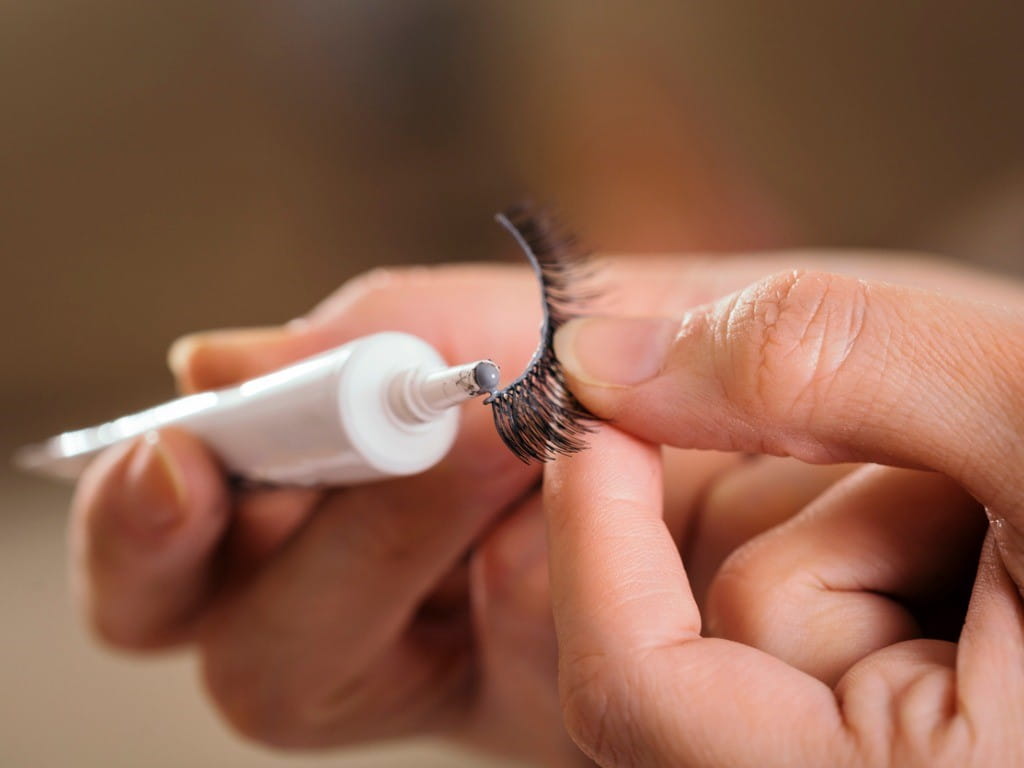Is Eyelash Glue Toxic?

The Bottom Line
Temporary lashes are attached above the natural eyelashes with a temporary adhesive, while semi-permanent lash extensions are attached to the natural lashes with cyanoacrylate, the adhesive in Super Glue. If either kind of adhesive is used incorrectly, it can cause injury.

How is eyelash glue different from other glues?
False eyelashes have gone from a look reserved for special occasions to an everyday necessity for some. Two popular ways to obtain those long, beautiful lashes are by wearing temporary lashes or by getting semi-permanent lash extensions applied by a licensed cosmetologist or esthetician.
Glues used to attach false eyelashes are similar to other adhesives in common use. Because they are applied so closely to the eyes, however, they must be handled with great care.
What is eyelash glue made of?
To apply temporary false lashes, lash adhesive is applied along the band of the false lashes to attach them directly above the natural lashes. This kind of lash adhesive is typically made of an adhesive component, solvents, surfactants, and ammonium hydroxide. Some adhesives contain glycol ethers, which are potentially toxic if swallowed. In addition, temporary lash adhesives can contain chemicals that are irritating to the skin and eyes, like alcohol and detergents.
Semi-permanent lash extensions last longer than temporary lashes (usually 6 to 8 weeks). Semi-permanent eyelash extensions are applied to each strand of the natural eyelashes with a semi-permanent glue, typically a cyanoacrylate adhesive. Cyanoacrylate is also found in instant bond glues like Super Glue. Even though they share some ingredients, it is important to never substitute one of these general-purpose glues for eyelash glue!
When liquid cyanoacrylate interacts with water or moisture in the air, the molecules in the cyanoacrylate join to bond surfaces together. It is a fast-acting adhesive that dries and sets within seconds. Cyanoacrylate can be an irritant to the skin and eyes in liquid form and when its fumes are inhaled. Cosmetologists who apply eyelash glue can develop contact dermatitis from repeated exposure. Once cyanoacrylate is dried, it is chemically inert. However, dried cyanoacrylate forms a small, solid lump that can be physically irritating to the eyes, skin, or mucous membranes.
How to remove false eyelashes
To remove temporary lashes, dab the top of the lashes with warm water, eyelash remover, or eye makeup remover to loosen the adhesive. If necessary, semi-permanent extensions can be loosened with an oil-based eye makeup remover or an oily substance such as coconut oil. However, removing semi-permanent lashes at home could result in pulling out natural lashes. If possible, semi-permanent lashes should be removed by a licensed professional.
Removing eyelash glue from skin
Do not rip cyanoacrylate glue off the skin, as this will also remove the skin. To remove temporary or semi-permanent lash adhesives from the skin, wash the skin well with water and soap. Soaking the body part in warm, soapy water might slowly loosen the glue. Petroleum jelly, mineral oil, or a topical antibiotic ointment might also help.
Some cyanoacrylate products intended for household use recommend acetone to remove the adhesive from skin, but acetone should not be used around the face, eyes, or near any mucous membranes. Do not use fabric, like a cotton ball or swab, to remove cyanoacrylate. Cyanoacrylate can react with cotton or wool to release enough heat to cause burns. If you are still unable to remove cyanoacrylate glue, do not worry. It will fall off by itself in about 3 days.
What if eyelash glue gets into my mouth?
Treatment for swallowing any lash adhesives includes rinsing out the mouth and drinking a few sips of water. A life-threatening airway obstruction can occur if a large amount of cyanoacrylate adhesive is swallowed or inhaled. If anyone is having trouble breathing, call 911. If hardened glue is stuck on the teeth, it can be removed by brushing the teeth gently with a toothbrush. Do not scrape the glue off the teeth as this can damage the enamel. The glue will come off in a few days and it’s ok if a little of the dried glue gets swallowed in the process.
I got eyelash glue in my eye. What should I do?
With eye exposures, you should immediately irrigate the eyes for 15 minutes. If the eyelids are sealed shut, do not force them open; the adhesive will eventually release. Persistent eye pain or symptoms might need medical examination and treatment.
If you think someone might be having adverse effects from an eyelash adhesive, immediately call Poison Control at 1-800-222-1222 or check the webPOISONCONTROL online tool for help. Whether you call or log on, expert assistance is available 24 hours a day.
Diana N. Pei, PharmD
Certified Specialist in Poison Information
Revised William G. Troutman, PharmD
Professor of Pharmacy Emeritus
Poison Control Media Information
Did you find this page helpful? If so, we need your support. Poison Control is in constant competition with misinformation online. Links to www.poison.org or our webPOISONCONTROL triage tool from other websites and blogs help internet searchers quickly find accurate information and Poison Control’s contact information in an emergency. If you use the content from this page, please provide attribution via a link back to this page, www.poison.org, or https://triage.webpoisoncontrol.org/#!/exclusions. By doing so, you could save a life. Thank you!
Poisoned?
Call 1-800-222-1222 or
Prevention Tips
- Keep eyelash adhesives out of the reach of children and pets.
- See a licensed professional to get semi-permanent lash extensions.
This Really Happened
Case 1. A 36-year-old woman had semi-permanent eyelash extensions applied. Two days later, she went to an emergency room because she thought some of the lash glue had gotten into her eyes. Her eyes were red and irritated. Poison Control recommended flushing the eyes with water and applying an ophthalmic ointment to help loosen the glue. Poison Control followed up 2 days later, and the woman said her eyes were feeling better but she still had some slight irritation.
Case 2. A parent unintentionally put temporary lash adhesive instead of an antibacterial eye ointment into the eye of a 14-year-old girl. Her eye was irrigated immediately after the incident. When they called Poison Control, the girl did not have any symptoms and she remained well.
For More Information
Tymia Y. How to take off false eyelashes. wikiHow. Updated October 1, 2021. Accessed July 19, 2024.
References
Poisoned?
Call 1-800-222-1222 or
Prevention Tips
- Keep eyelash adhesives out of the reach of children and pets.
- See a licensed professional to get semi-permanent lash extensions.
This Really Happened
Case 1. A 36-year-old woman had semi-permanent eyelash extensions applied. Two days later, she went to an emergency room because she thought some of the lash glue had gotten into her eyes. Her eyes were red and irritated. Poison Control recommended flushing the eyes with water and applying an ophthalmic ointment to help loosen the glue. Poison Control followed up 2 days later, and the woman said her eyes were feeling better but she still had some slight irritation.
Case 2. A parent unintentionally put temporary lash adhesive instead of an antibacterial eye ointment into the eye of a 14-year-old girl. Her eye was irrigated immediately after the incident. When they called Poison Control, the girl did not have any symptoms and she remained well.
